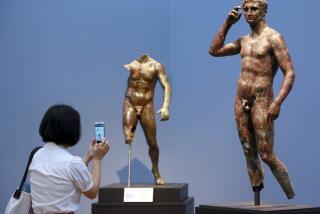Reporter Testifies at Trial of Ex-Getty Curator
- Share via
ROME — The Italian court trying the former curator of Los Angeles’ J. Paul Getty Museum heard testimony Wednesday from a British investigative journalist whose reports over the last decade helped launch Italy’s crusade to stop the rampant smuggling of its archeological treasures.
Testimony from the journalist, Peter Watson, shed further light on what prosecutors say is the tangled art-smuggling conspiracy involving Marion True, the Getty’s former antiquities curator, and her co-defendant, American art dealer Robert E. Hecht Jr. Another co-defendant, Italian art dealer Giacomo Medici, has been convicted in a separate trial.
In a hearing that almost turned comical because of the poor quality of the translations of Watson’s comments from English to Italian, the court reviewed a pile of documents provided by the journalist that prosecutors said showed the link between smugglers and top-line auction houses such as Sotheby’s.
The potentially most damaging piece of evidence presented Wednesday was Watson’s statement that he has copies of Polaroid photographs showing the Getty’s majestic statue of the Greek goddess Aphrodite in a “more primitive status, without an arm.”
Italian authorities have successfully used similar photos of antiquities before they have been restored to establish that the objects had been recently excavated and smuggled out of the country.
Italian prosecutors also presented a note handwritten in French that appeared to indicate that Hecht had financed the allegedly illicit purchase of the Aphrodite, one of the gems of the Getty collection and one of more than 40 objects in Italy’s case against True.
“Bought in 1987, financed by Robert Hecht, sold in 1988, through RS at the Getty Museum,” the note said.
Prosecutors believe “RS” refers to Robin Symes, a British antiquities dealer who occasionally worked with Hecht. The document was found in Symes’ warehouse, and authorities here say he fronted looted artifacts to high-end clients, including museums and galleries.
Hecht, contacted Wednesday, denied that he financed the purchase.
“I never saw or had to do with that Aphrodite,” Hecht said. “I did not finance it. That’s a joke.”
Symes “got his financing elsewhere, not from me,” Hecht said. “If I had bought the Aphrodite, I would have sold it myself.”
In the court session, Watson, who recently finished writing a book about the case based in part on documents provided by Italian authorities, recounted an anecdote about the relationship between True and Medici.
During a dinner at a conference in August 2001 at UCLA, the topic of conversation was Medici’s trial, he said. Although most of those in attendance referred to him as “Medici,” True spoke of him as “Giacomo” and in a “very tender way,” Watson said.
“I asked her, ‘Marion, do you know Giacomo Medici?’ She blushed and said, ‘No, no, no,’ ” Watson testified.
True was indicted in May of last year, and the trial began in earnest Dec. 5. She has denied the charges against her, and her lawyers say she always acquired antiquities for the Getty in good faith.
One of her attorneys, Francesca Coppi, said after the hearing Wednesday that Getty attorneys came to Rome this week to meet with True. Coppi said the museum was investigating 100 items, a figure that is nearly twice the number Italian authorities have called into question.
*
Times staff writer Jason Felch in Los Angeles contributed to this report.
More to Read
The biggest entertainment stories
Get our big stories about Hollywood, film, television, music, arts, culture and more right in your inbox as soon as they publish.
You may occasionally receive promotional content from the Los Angeles Times.










